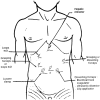Early experience with laparoscopic approach for solid liver tumors: initial 16 cases
- PMID: 11066134
- PMCID: PMC1421217
- DOI: 10.1097/00000658-200011000-00004
Early experience with laparoscopic approach for solid liver tumors: initial 16 cases
Abstract
Objective: To evaluate the feasibility and outcome of laparoscopic hepatectomy in patients with solid liver tumors.
Summary background data: Although the laparoscopic approach has become popular in the surgical field, the value of laparoscopy in liver surgery is unknown.
Methods: Fifteen patients with solid liver tumors underwent 16 consecutive laparoscopic resections at the authors' institution between 1994 and 1999. Indications were symptomatic hemangioma, focal nodular hyperplasia, liver cell adenoma, isolated metastasis from a colon cancer, and hepatocellular carcinoma. The laparoscopic procedure was performed using four to seven ports (four 10-mm, two 5-mm, and one 12-mm).
Results: One patient underwent a major hepatic resection (right lobectomy); the others underwent minor hepatic resections (left lateral segmentectomies, IVb subsegmentectomies, segmentectomy, and nonanatomical excisions). The laparoscopic procedure was uneventful in 15 patients; one patient required conversion to open laparotomy because of inadequate free surgical margins.
Conclusion: Laparoscopic surgery of the liver is feasible. The use of this new technical approach offers many advantages but requires extensive experience in hepatobiliary surgery and laparoscopic skills. The authors' experience suggests that laparoscopic procedures should be reserved for benign tumors in selected cases. Its application must be verified by further studies.
Figures
References
-
- Dubois F, Berthelot G, Levard H. Laparoscopic cholecystectomy: historical perspective and personal experience. Surg Laparosc Endosc 1991; 1: 52–60. - PubMed
-
- Clayman RV, Kavoussi LR, Soper NJ, et al. Laparoscopic nephrectomy. N Engl J Med 1991; 324: 1370–1371. - PubMed
-
- Gagner M, Lacroix A, Bolte E. Laparoscopic adrenalectomy in Cushing’s syndrome and pheochromocytoma. N Engl J Med 1992; 327: 1033. - PubMed
-
- Lefor AT, Melvin WS, Bailey RW, Flowers JL. Laparoscopic splenectomy in the management of immune thrombocytopenia purpura. Surgery 1993; 114: 613–618. - PubMed
-
- Lefor AT, Flowers JL. Laparoscopic wedge biopsy of the liver. Am Coll Surg 1994; 178: 307–308. - PubMed
MeSH terms
LinkOut - more resources
Full Text Sources
Medical



